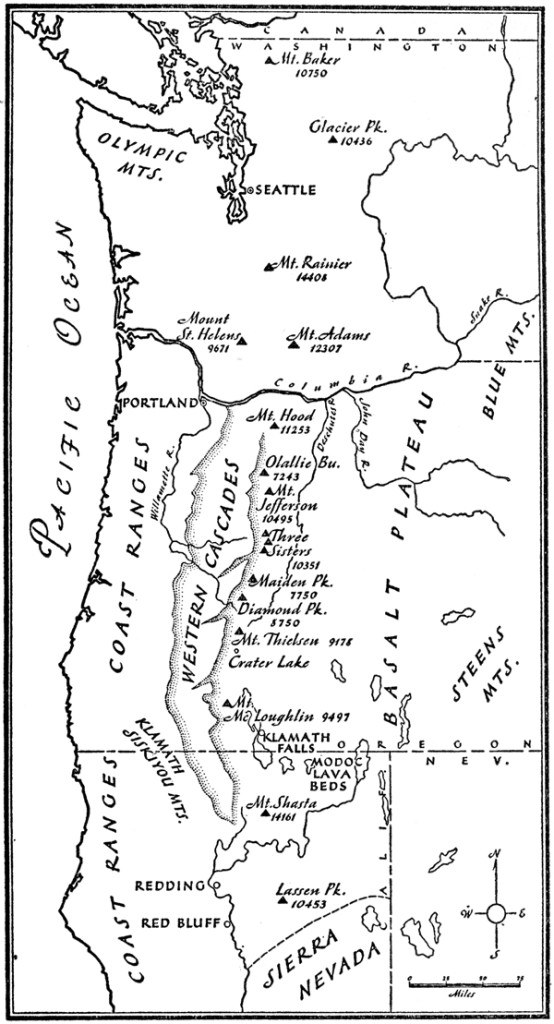The Geology of Crater Lake National Park, Oregon With a reconnaissance of the Cascade Range southward to Mount Shasta by Howell Williams
The Foundations of Mount Mazama
The Western Cascade Volcanic Series
Age of the Western Cascade Series
Much work remains to be done before the precise age of these rocks can be determined, though enough is already known to suggest that, in general, volcanic activity commenced later at the southern end of the belt than farther north.
In Washington, as we have seen (p. II), volcanism began as early as Lower Eocene time. In the Roseburg area, volcanoes had certainly commenced to erupt by Upper Eocene time, at first beneath the sea and later on land, for the lower part of the Calapooya formation, a local member of the Western Cascade series, contains an Upper Eocene subtropical flora similar to that of the Clarno formation of the John Day Basin. Farther south, in the Ashland-Medford valley, some of the earliest of the Western Cascade volcanics contain a temperate flora which Chaney5 assigns to the Lower Miocene or Upper Oligocene. Still farther south, near Hornbrook, in California, the basal tuffs have yielded a flora of Upper Eocene or Oligocene age.

Fig. 2. Map of the Cascade Range. (Drawn by A. W. Severy.) |
The upper age limit of the Western Cascade series is no less indefinite. Writing of the belt west of Mount Jefferson, in northern Oregon, Thayer7 states that the basal rhyolites are possibly equivalent to the upper part of the Clarno (Eocene) series east of the Cascades. On these rest water-worked and land-laid pyroclastic deposits, the Breitenbush beds, which he regards as equivalent to the John Day series (Lower Miocene and Upper Oligocene), and then a thick series of lavas, the Stayton and Sardine flows, which probably interfinger with the Middle Miocene Columbia River basalts of eastern Oregon. All these Western Cascade volcanic rocks were folded, faulted, mineralized, and intruded by stocks of diorite, and had been considerably eroded before the High Cascade volcanoes commenced their growth in Pliocene times.
Southwest of Crater Lake, on the slopes of Grizzly Peak, near Ashland, well up in the Western Cascade series though still several thousand feet from the top, Chaney obtained a temperate to warm-temperate Upper to Middle Miocene flora similar to that of the Mascall formation east of the Cascades.
Tentatively, therefore, we conclude that in the part of the Western Cascades closest to Crater Lake, volcanic activity commenced in the Upper Eocene and continued until the close of the Miocene, by which time volcanic rocks had accumulated to a thickness of 7000 to 10,000 feet. And here, as in northern Oregon, this vast series of lavas and pyroclastics had been invaded by stocks of diorite and had been gently deformed before the High Cascade cones began to rise.
Throughout the period when the Western Cascade volcanic rocks were being erupted, there was almost continuous volcanic activity in the region east of the Cascade Range, where the Clarno, John Day, Columbia River, and Mascall formations were being laid down. In the eastern part of the Klamath quadrangle, bordering Sprague River, are several inliers of older volcanics. Moore8 regards these as equivalents of the Payette (Miocene) formations to the east. There can be no doubt, therefore, that the eastward-dipping volcanics of the Western Cascades pass beneath the Crater Lake region and interfinger with the early Tertiary volcanics on the plateau farther east.
***previous*** — ***next***

